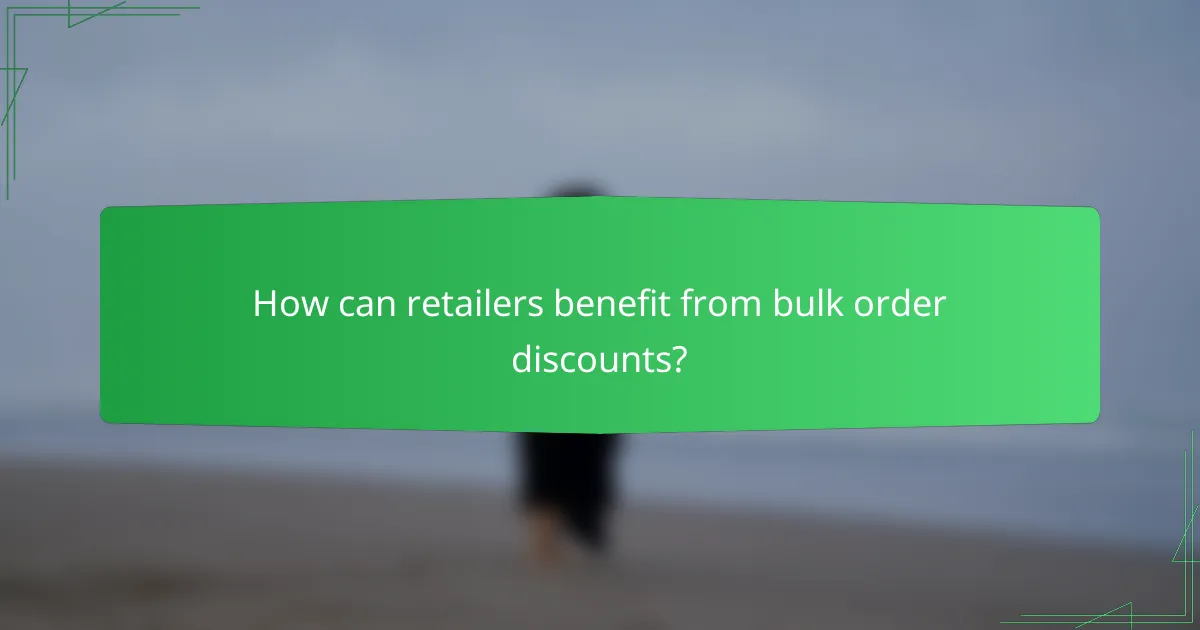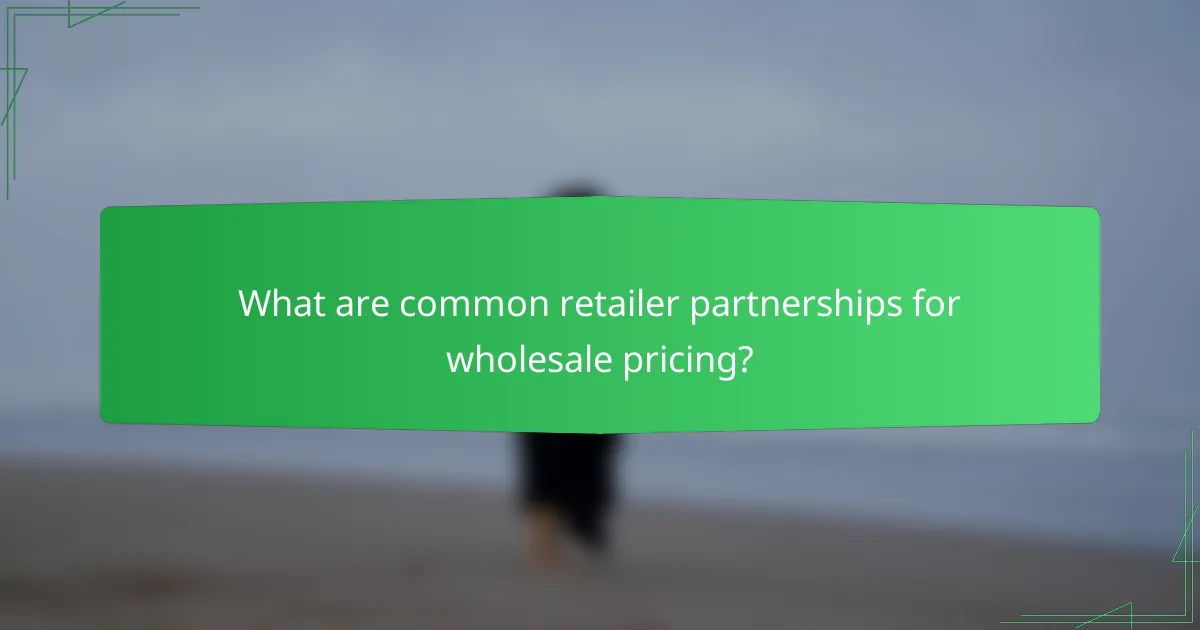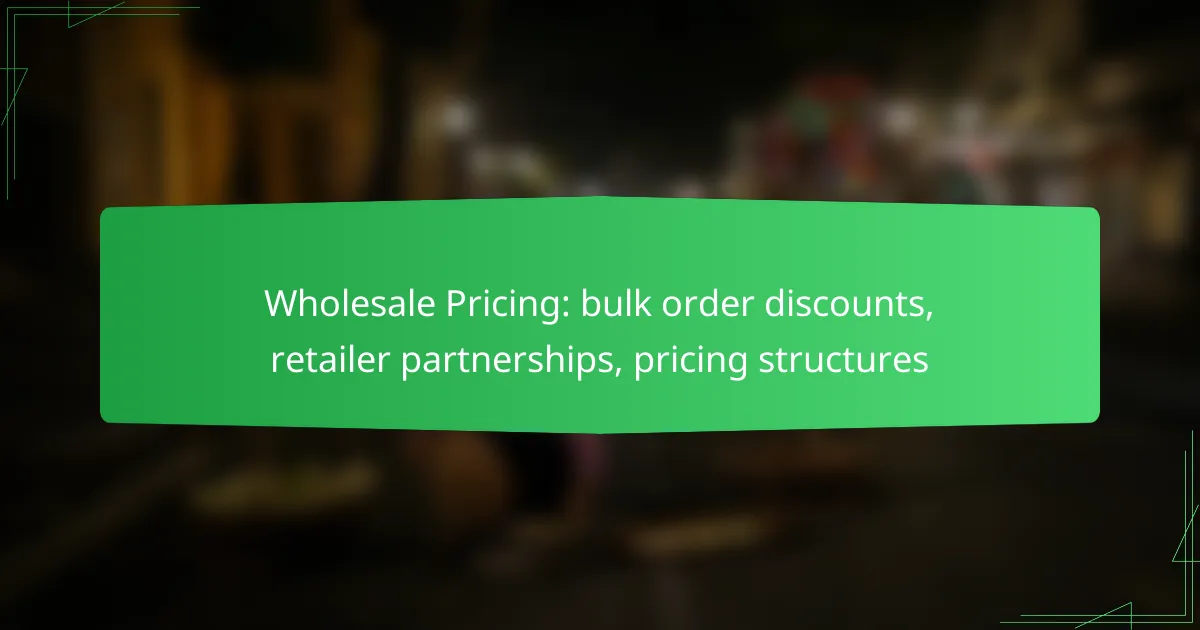Wholesale pricing plays a crucial role in the retail industry, as it determines the cost at which retailers can purchase products in bulk. By leveraging bulk order discounts, retailers can reduce their costs and improve profit margins, while strategic partnerships with suppliers and distributors further enhance their pricing structures. Understanding these dynamics is essential for retailers aiming to remain competitive in the market.

What are wholesale pricing structures in the UK?
Wholesale pricing structures in the UK refer to the various methods suppliers use to determine the prices offered to retailers for bulk purchases. These structures often include discounts based on order size, allowing retailers to maximize their profit margins while ensuring competitive pricing.
Tiered pricing models
Tiered pricing models offer different price levels based on the quantity purchased. For instance, a supplier might charge £10 per unit for orders of 1-50 units, £9 for 51-100 units, and £8 for orders exceeding 100 units. This approach incentivizes retailers to buy larger quantities to benefit from lower prices.
When considering tiered pricing, retailers should analyze their sales forecasts to determine the most cost-effective order size. It’s essential to balance inventory costs with the potential savings from higher volume purchases.
Flat rate discounts
Flat rate discounts provide a fixed percentage off the total order value, regardless of quantity. For example, a supplier might offer a 15% discount on all orders over £500. This pricing structure is straightforward and easy for retailers to calculate, making it appealing for those who prefer simplicity.
Retailers should assess their purchasing patterns to determine if flat rate discounts align with their buying habits. It’s crucial to ensure that the minimum order value for discounts is achievable without overextending cash flow.
Volume-based pricing
Volume-based pricing is similar to tiered pricing but focuses on the total volume of products ordered over a specific period, rather than per transaction. For instance, a retailer might receive a discount after reaching a cumulative total of 1,000 units within a quarter. This model encourages long-term purchasing commitments.
Retailers should track their cumulative purchases carefully to take full advantage of volume-based pricing. Establishing a reliable ordering schedule can help ensure they meet the necessary thresholds for discounts without excess inventory buildup.

How can retailers benefit from bulk order discounts?
Retailers can significantly enhance their profitability through bulk order discounts, which allow them to purchase larger quantities of products at reduced prices. This not only lowers their overall cost per unit but also enables them to maintain competitive pricing in the market.
Increased profit margins
By taking advantage of bulk order discounts, retailers can improve their profit margins. For instance, purchasing items at a 20% discount can allow retailers to either increase their markup or lower their selling price, making their products more appealing to customers.
It’s essential to analyze the cost structure before committing to bulk purchases. Retailers should consider factors like storage costs and potential spoilage, which can affect overall profitability. A well-planned inventory strategy can maximize the benefits of bulk buying.
Competitive pricing advantages
Bulk order discounts provide retailers with a competitive edge by enabling them to offer lower prices than their competitors. This can attract more customers and increase sales volume, particularly in price-sensitive markets.
Retailers should regularly compare their pricing against competitors to ensure they leverage bulk discounts effectively. Implementing promotional strategies, such as limited-time offers or loyalty programs, can further enhance the attractiveness of their pricing to consumers.

What are common retailer partnerships for wholesale pricing?
Common retailer partnerships for wholesale pricing include agreements with suppliers and collaborations with distributors. These partnerships are essential for retailers to secure favorable pricing structures and bulk order discounts, ultimately enhancing their profit margins.
Supplier agreements
Supplier agreements are formal contracts between retailers and manufacturers or wholesalers that outline pricing, delivery schedules, and terms of sale. These agreements often include bulk order discounts, which can significantly reduce the cost per unit for retailers.
When negotiating supplier agreements, retailers should consider factors such as minimum order quantities, payment terms, and the flexibility of pricing based on order volume. For example, a retailer might secure a discount of 10-20% for orders exceeding a certain threshold, which can be crucial for managing cash flow.
Distributor collaborations
Distributor collaborations involve partnerships with intermediaries who handle the logistics of getting products from suppliers to retailers. These collaborations can streamline the supply chain and often come with their own pricing advantages.
Retailers should evaluate the benefits of working with distributors, such as reduced shipping costs and access to a wider range of products. It’s common for distributors to offer tiered pricing based on the volume of goods ordered, allowing retailers to benefit from economies of scale. For instance, a retailer might receive a 15% discount for orders over a specific quantity, making it easier to compete in the market.

What factors influence wholesale pricing in e-commerce?
Wholesale pricing in e-commerce is influenced by various factors including market demand, product category, and shipping costs. Understanding these elements can help retailers negotiate better deals and optimize their pricing strategies.
Market demand
Market demand significantly impacts wholesale pricing. When demand for a product is high, wholesalers may increase prices due to limited supply. Conversely, if demand is low, prices may decrease to encourage sales.
Retailers should monitor market trends and consumer behavior to anticipate changes in demand. Utilizing tools like Google Trends or industry reports can provide insights into what products are gaining popularity.
Product category
The product category plays a crucial role in determining wholesale pricing. Categories with high competition, such as electronics, often have lower margins, while niche products may allow for higher markups. Understanding the dynamics of your specific category can guide pricing strategies.
For example, seasonal items like holiday decorations may see fluctuating prices based on demand spikes during certain times of the year. Retailers should consider these variations when planning their inventory and pricing.
Shipping costs
Shipping costs are a vital consideration in wholesale pricing. These costs can vary based on distance, weight, and shipping method, directly affecting the final price retailers pay. Wholesalers often factor in these expenses when setting their prices.
To minimize shipping costs, retailers can negotiate bulk shipping rates or consider local suppliers. Additionally, consolidating orders can lead to lower per-unit shipping expenses, improving overall profitability.

How do retailers negotiate wholesale prices?
Retailers negotiate wholesale prices by leveraging factors such as order volume and contract length to secure better deals. Understanding the dynamics of these negotiations can lead to significant cost savings and improved profit margins.
Volume commitments
Volume commitments refer to the quantity of products a retailer agrees to purchase from a wholesaler over a specific period. Higher volume orders often lead to lower per-unit costs, as wholesalers are willing to offer discounts to secure larger sales. Retailers should assess their sales forecasts to determine feasible order sizes that can maximize discounts without overstocking.
For instance, a retailer might negotiate a 10% discount for committing to purchase 1,000 units per month instead of 500. This strategy not only reduces costs but also strengthens the relationship with the wholesaler, potentially leading to better terms in the future.
Long-term contracts
Long-term contracts involve agreements between retailers and wholesalers that extend over several months or years. These contracts can provide stability in pricing and supply, allowing retailers to plan their budgets more effectively. In many cases, wholesalers offer lower prices in exchange for the security of guaranteed sales over time.
For example, a retailer might sign a one-year contract for a specific product line, securing a fixed price that protects against market fluctuations. Retailers should carefully evaluate the terms of these contracts, ensuring they align with their business goals and market conditions to avoid being locked into unfavorable terms.

What are the prerequisites for establishing retailer partnerships?
Establishing retailer partnerships requires several key prerequisites, including proper business registration, a clear understanding of pricing structures, and effective communication strategies. These elements help ensure a smooth collaboration and mutual benefit for both parties involved.
Business registration
Business registration is essential for establishing credibility and legality in retailer partnerships. This process typically involves registering your business name, obtaining necessary licenses, and complying with local regulations. Depending on your location, this may require filing with state or national authorities.
When registering, ensure that you choose the appropriate business structure, such as a sole proprietorship, partnership, or corporation. Each structure has different implications for liability, taxes, and operational flexibility. For example, corporations may provide limited liability protection, while sole proprietorships are simpler to set up but expose personal assets to business risks.
In addition to registration, consider obtaining an Employer Identification Number (EIN) if you plan to hire employees or operate as a corporation. This number is often required for tax purposes and can streamline your interactions with retailers and suppliers.
